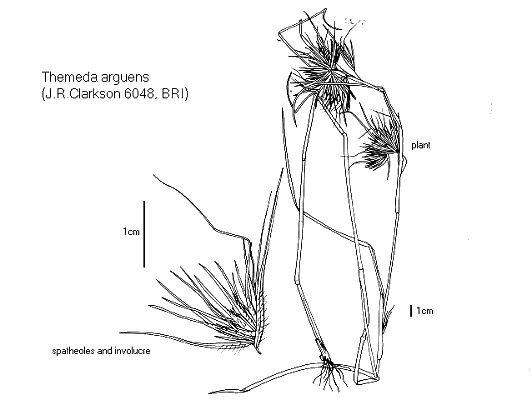 |
 |
|
 |
 |
|

Themeda arguens (L.) Hack.
|
Derivation
Themeda Forssk., Fl. Aegypt.-Arab. 178 (1775); from the Arabic
thaemed (little water), possibly referring to water storage cells on
the upper surface of the leaves or to the habitat of the type specimen in Yemen,
fide L.K.A.Chippindall & A.O.Crook, Grasses of Southern Africa
(1976).
arguens- from the Latin arguo (content).
Published in
Monog. Phan. 6: 657 (1889).
Common synonyms
Themeda frondosa (R.Br.) Merr.
Habit
Annual, tufted. Culms erect or geniculately ascending, 20–300 cm tall.
Leaves mostly basal. Ligule an eciliate membrane, 1 mm long. Leaf-blade base
broadly rounded. Leaf-blades flat or conduplicate, 5–30 cm long, 4–7
mm wide. Leaf-blade apex acuminate.
Inflorescence
Inflorescences arranged within a synflorescence. Inflorescence terminal and
axillary, subtended by a spatheole, enclosed. Spatheole lanceolate, 2.5–4
cm long, scarious, without tubercles or tuberculate, glabrous or pilose. Rames
single, cuneate, bearing a few fertile spikelets, bearing 1 fertile spikelets
on each. Rhachis fragile at the nodes.
Spikelets
Spikelets in threes (basal paired). Pedicels oblong, 1 mm long, tip oblique.
Basal sterile spikelets represented by a single scale, 4 in number, forming
an involucre about the fertile, with both pairs arising at about the same level,
subsessile. Basal sterile spikelets 6–10 mm long, equalling fertile. Basal
sterile spikelet glumes smooth, glabrous. Basal sterile spikelet lower glume
muticous. Companion spikelets developed, comprising 2 subequal glumes without
lemmas, lanceolate, 6–10 mm long, shorter than fertile, separately deciduous.
Companion spikelet callus linear, 2–3 mm long, truncate. Companion spikelet
glumes herbaceous, glabrous, acuminate. Fertile spikelets 2-flowered, comprising
1 fertile floret, lower floret sterile, upper fertile, without rhachilla extension,
elliptic, terete, 8–11 mm long, falling entire, deciduous with accessory
branch structures. Spikelet callus linear, 3–4 mm long, bearded, base pungent,
attached obliquely. Spikelet callus hairs red.
Glumes
Glumes dissimilar, firmer than fertile lemma. Lower glume oblong, equalling
spikelet, coriaceous, dark brown, 7-nerved. Lower glume surface smooth, pilose
or hispid, hairy above. Lower glume hairs dark brown. Lower glume apex truncate.
Upper glume oblong, coriaceous, with membranous margins, 3-nerved. Upper glume
surface pilose, hairy above. Upper glume margins ciliate. Upper glume hairs
dark brown. Upper glume apex truncate.
Florets
Basal sterile floret 1, without significant palea. Lemma of lower sterile floret
oblong, 2.8 mm long, hyaline, ciliate on margins. Fertile lemma oblong, 3 mm
long, hyaline, 1-nerved. Lemma apex entire, 1-awned. Median (principal) awn
apical, geniculate, 50–90 mm long overall, with a twisted column. Column
hispidulous. Palea absent or minute. Anthers 1.4 mm long.
Continental Distribution:
Tropical Asia, Australasia, Pacific, South America.
Australian Distribution:
Western Australia, Northern Territory, Queensland.
Western Australia: Gardner. Northern Territory: Darwin & Gulf. Queensland: Burke, Cook, North Kennedy, South Kennedy.
Classification. (GPWG
2001):
Panicoideae: Andropogoneae
Notes
A fairly widespread tropical species from northern regions of W.A., N.T. and
Qld and extending through SE Asia to the Andaman Is. Flowers Feb.–Sept.

Habit, spatheole and involucre (line drawing)
© Queensland Herbarium
by Will Smith